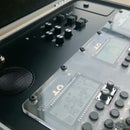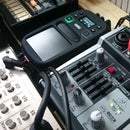Introduction: Office Arcade Machine
For those of you who expected this to be yet another handmade synthesizer case it might be a little disappointing, but today I'd like to share our experience building a full size arcade machine for our office.
It was a collaborative effort by a bunch of software developers from Issuu, a kick-ass digital publishing platform, and we've done everything right at the office.
Unfortunately, we did not plan to make it an instructable in the beginning, but after we finished the project we found out that we have plenty of photos to cover the whole build process. I tried to organize them in meaningful steps, some parts are obviously missing, so please feel free to ask any questions in the comments.
Step 1: Video Tutorials and a List of Things You Will Need
None of us had experience building arcade machines before, nor have we built anything as big as this thing from scratch. Luckily, there were more than enough relevant videos on YouTube.
We've made a google doc with a list of things we thought we needed and ordered the most of it from the nearest hardware store. There was already a basic setup with Raspberry Pi, X-Arcade Tankstick and a 40" TV in our office, so this project was about taking the electronics we had and building a nice cabinet for it.
Step 2: Side Panels
We started with MDF sheets cut down to the size that we needed, so we only had to cut the side panel shapes. Wood strips were useful to draw the straight lines, kitchen plates and coffee cups helped us to draw the curves.
We cut one of the side panels with a jig saw and used it as a template to mark and cut the other one. It's pretty difficult to make a straight cut with a jig saw, especially when you are doing it for the first time in your life, so we used sand paper to smooth the bumps and filled the pits with an MDF filler.
When you sand MDF it makes a lot of dust, so it's strongly recommended to wear a protective mask.
Step 3: Body
The body assembly was pretty trivial. Metal angles, strip wood, wheels and holes for buttons and speakers.
Step 4: Painting
We applied two coats of regular wood paint with some light sanding in between
Step 5: Joysticks and Buttons
Now it was time for the joysticks. As I already mentioned, we had an X-Arcade Tankstick. It might be not the cheapest option to go with, but it's definitely the easiest one. It's USB powered, has a decent controller board and is recognized as two joysticks by the RetroPie out of the box.
We've put labels on all wires, disassembled the tankstick and mounted all the buttons into the front panel of the arcade cabinet.
Step 6: Electronics
On the bottom of the cabinet we placed a subwoofer and a power extension cord. The Raspberry Pi is mounted with velcro tape on the side under the display for easier accessibility. The display had a VESA mount, which we attached to strip wood through metal plates with M4 bolts.
At that point the arcade cabinet was basically done. We were going to put some graphics on it whenever we have time, but it was already good enough.
Step 7: Spray Painting
A few months later we had a big company event, when all our colleagues from Palo Alto, Berlin and New York were visiting our office in Copenhagen. The event had its own style and logo, so we thought it was a great occasion to finish the arcade.
We sketched some design, bought some spray paint and set up a painting booth right in the office next to a big window. Of course we underestimated the complexity of the process, so some of us had to stay in the office after midnight to finish it. But the next morning everybody were astonished with the result.
Step 8: Stickers!
Many people contributed by putting stickers on the front panels
Step 9: Result
And here it is - Issuu Arcade Machine also known as Arkadievich!
The entire build process took us around 4 full days of work, but it is possible to build a working version over a weekend with your friends, especially if you go with vinyl stickers instead of spray paint.
We still need to make a proper marquee. I think I will just update this instructable after we get it done.













